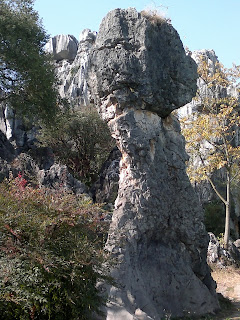Southwest
of Kunming on a 2000m plateau lies the Dianchi Lake. It is the sixth
largest freshwater lake in China covering 300 sq. km in area. Large
bodies of water are usually on the tourist's must-see list,
and this lake is no exception.
To enjoy a magnificent view of the lake, on the third day of our trip we
travelled 40 mins by road to the Western Hills which is a forested area
40 km long on one bank of the Dianchi. We had to get up to the Dragon
Gate following hundreds of steps which had been carved into a cliff-side
by Taoist monks of yore.
Along the way we came across a few temples
where various deities are housed. It was quite a climb but the
designated eco-bus had already taken us about halfway up, and
there were many places where we stopped to rest and took pictures.
Some people took the easy way up by chair-lift and then walked down. We
decided to do the opposite, Riding in one of those contraptions
turned out to be very relaxing after the climb and the scenery more
breath-taking. We followed this by a cable-car ride down to the opposite
side of the lake.
Can't help mulling over the fact that when we are holidaying in other lands, we sometimes find ourselves taken to places we never think twice about not visiting when we are at home, especially places of worship belonging to faiths other than our own.
I have found myself in temples in Bali, Japan and China, and cathedrals in Europe looking incredulously at elaborately carved and painted deities, statues and gargoyles and feeling I should not be there and what if an earthquake suddenly happens and I, a Muslim am buried alive amongst them.
I wonder if we can count casinos as places of worship too, knowing some people visit it religiously in the weekends for monetary, if not spiritual, cleansing/enhancement as the outcome might be... Whatever, that is one place I have never stepped into and also would not want to be near in the event of an earthquake.
The last place on the tourist map that we visited in Kunming was the Taoist Golden Temple. It is located on top of a hill, the Singing Phoenix (because it looks like one apparently), and you approach it by climbing up on stone steps and pass through a series of "Heavenly Gates".
Before heading back to the city, we walked through the temple grounds which is a serene park of tall cypress trees dotted with bronze relics and bonsai plants here and there.
The next day was our last in Kunming. We spent a few hours before leaving for the airport buying some souvenirs at the Bird and Flower market, doing some city sightseeing and finally dropping by at the Nanying mosque for solat and some noodly lunch.
It was the perfect way to end our visit, in a place which felt quite familiar, and okay to be should an earthquake happen :)

































